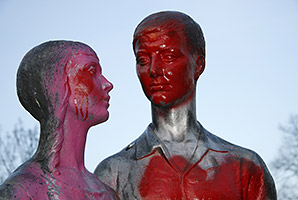Art Basel
One sculpture, a thousand shards and one million dollars in damage
When a wanna-be graffitist added a second coat of color to a bronze sculpture located in a public area of the German town of Remschied, the bronze’s extremely fine pores soaked the paint up like a sponge. The customer was afraid the piece was beyond repair. Far from it. Allianz found a restorer who was able to remove the paint without leaving any residue so that the sculpture could be repatinated and returned, signed and sealed by the artist.
2. Transport damage:
Fine art should to be displayed. Exhibitions, however, put pieces under a tremendous amount of strain, particularly during transportation, when they are subjected to jolts and shocks that can sometimes be just too much. In one of Allianz’ most spectacular cases, a supporting frame collapsed under the weight of an exceptionally large and heavy sculpture. The objet d’art fell 30 cm to the ground and shattered into pieces. The result? A total write-off to the tune of one million dollars.
3. Visitor-related damage:
Museums employ sophisticated security measures, such as cordons and electronic proximity sensors, to ensure that such dramatic incidents as the 1988 acid attack on several of the Albrecht Dürer works housed in the Alte Pinakothek in Munich are the exception and not the rule. It’s different in a private environment, where accidents are the primary cause of damage. In one such example, at the end of an art soiree a customer was hosting to show off his valuable photography, he noticed that someone had spilled wine spritzer on it.
4. Moisture:
5. Mold:
While proudly showing off his glass-enclosed 19th century harness and saddle, upon closer inspection, a customer and one of our art experts noticed a thick layer of mold. The art expert found a leather restorer who was able to return the pieces to their former glory.

More information
Forward Looking Statement disclaimer
As with all content published on this site, these statements are subject to our Forward Looking Statement disclaimer: